Translations:
Other Pages:
CEC Training Modules
Akan Studies Site Map
Sociology for beginners
Contact
Kompan Adepa
Go to the People
Ghana Web
Cocoa
Ghana's Largest Cash Crop
by Phil Bartle, PhD
Where Cocoa Originated
There are different stories of how Ghana's "black gold," cocoa, was introduced to Ghana. It was an indigenous plant in the rain forests of central and southern America, and so rare and expensive that only the royalty of Inca or Aztecs were permitted to eat it. (Do not confuse this with the coca plant whence cocaine is derived). It was used to coat turkeys (also indigenous to the Western hemisphere) when they were roasted or baked. Cultivating the plant by commoners was forbidden, and it was considered traitorous to export the plant. The Portuguese and Spanish both stole cocoa plants to grow elsewhere. An important up market meal in Mexico today is chicken coated with chocolate. When introduced to Europe, cocoa and the chocolate made from it, were very expensive, and a luxury only the wealthy could afford.
The Swiss were interested in developing chocolate products as an expensive luxury food. The Swiss Missionaries who came to the Gold Coast in the early nineteenth century, and to Kwawu in 1888, wanted to convert the local people to cash cropping so as to monetize their economy. By that time it was grown in Sao Palme, introduced there by the Portuguese. Ghanaian oral history relates that Tetteh Quarshi went to Sao Palme and stole some live beans to bring back and cultivate in the Gold Coast.
 |
Tetteh Quarshi as Wall Art
The Swiss set up a collecting warehouse, called a "factory," to collect the cocoa beans from the cash crop farmers and ship them to Switzerland, making Switzerland a name for itself as a producer of fine chocolate. The first half of the twentieth century was characterised by a large and rapid expansion of commercial cash cropping of the cocoa. Each farm was organized, often by a wealthy trader with enough capital, mainly men and some women. They went to the north of the country to find labourers, historically seen as slaves by the Akan, to come and work on the cocoa farms. This was very different from subsistence farming by women for food. The second half of the century saw the slowing of the expansion and decline of the industry because of a series of national blunders in export and farm policies, and because the rape of the large hardwoods (poor enforcement of rules against that) which depleted the source of forest protection for the cocoa plants.
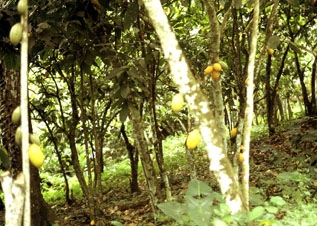 |
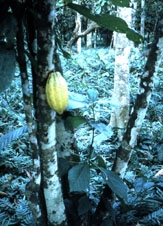 |
 |
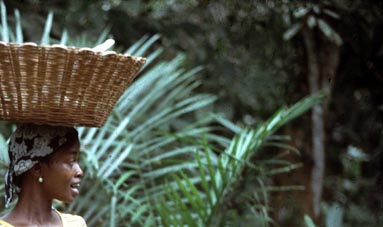 |
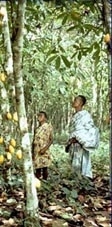 |
Cocoa Pods Grow on the Trunk, Not on Branches
 |
Cocoa Beans Taken Out of the Pods
The cocoa tree must grow under the big rain forest hardwoods to be sheltered from the heavy sun. The pods grow on the side of the trunk, not on the branches. The pods must be harvested, split open to obtain the beans, and they allowed to ferment in the forest floor, for the outer pulp to fall off, before they are brought to the village to dry.
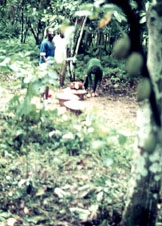 |
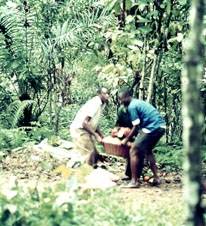 |
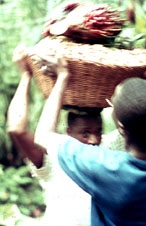 |
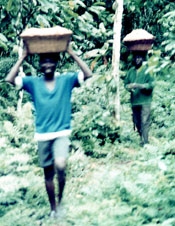 |
Poor Photos. Sorry. Cocoa Harvesting after Fermentation
 |
Drying the Cocoa Beans
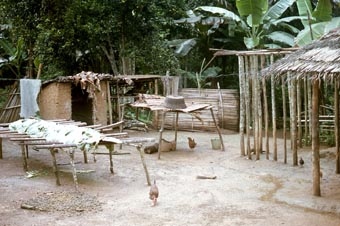 |
Covering the Cocoa Beans When it Rains
 |
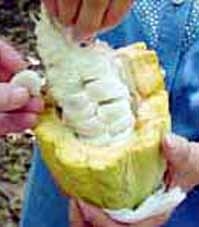 |
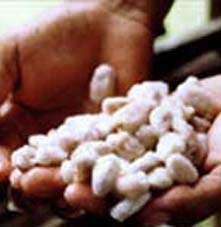 |
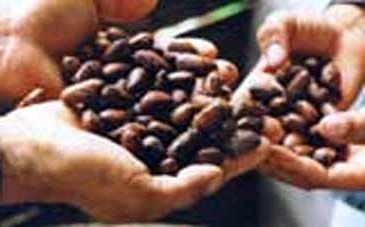 |